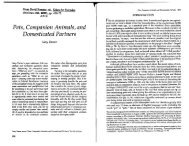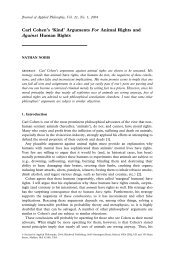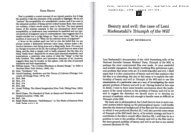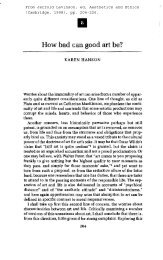36 Environmental disobedience - Ned Hettinger
36 Environmental disobedience - Ned Hettinger
36 Environmental disobedience - Ned Hettinger
You also want an ePaper? Increase the reach of your titles
YUMPU automatically turns print PDFs into web optimized ePapers that Google loves.
ENVIRONMENTAL DISOBEDIENCE 503examples of lawbreaking of that type. For example. that civil <strong>disobedience</strong> is sometimesmorally justifiable does not entail that every instance of it is. When LesterMaddox (a famous segregationist) openly refused to obey laws requiring that hepermit African-Americans into his restaurant. his act of civil <strong>disobedience</strong> was notjustifiable. But this does not mean we should refuse to allow individuals to decidewhen civil <strong>disobedience</strong> is morally appropriate. Similarly, leaving open the possibilitythat militant action or violence in support of environmental goals may be permissibledoes not require that we accept the Unabomber's use of violence.Allowing violence as a tactic for social change is dangerous. and many would ruleit out entirely and in principle, especially in a democratic society. Such views too oftenfail to distinguish between types of violence, equating all violent activity with terrorism,and condemning it all in absolute terms. Those who have written in defense ofthe use of violence for environmental goals make a distinction between violenceaimed at persons and violence aimed at property and have (almost) universallylimited the "violence" they condone to property destruction or sabotage. Their statedgoal is to harm no living being (human or otherwise), but to destroy the machinerythat attacks the living earth. This distinction is important. In a democratic society,violence aimed directly at persons is almost impossibly difficult to justify. Violenceagainst property does not confront nearly as high a hurdle. But we must not let thisdistinction delude us into thinking that violence against property has no harmfuleffects on people. as if only things are being hurt and not people (MorreaU 1991[1976]. p. 133). Those who own property are going to be hurt by damage to it;damaging property that no one cares about would be totally ineffective. Still. legalactivity and non-violent civil <strong>disobedience</strong> can inflict greater harm than do some actsof property destruction. A massive road-blocking protest can inconvenience thousandsand impose high costs on local governments who must arrest and prosecuteprotestors. Businesses can be more threatened and injured by legal strikes andboycotts than by small-scale sabotaging of equipment.Those who believe that violent lawbreaking can sometimes be justified argue thatthe absolute prohibitionists rely on an untenable act/omission distinction (Singer1993. p. 307fT). They point to situations where only violent illegal activity can stopothers from committing much greater violence. The earlier mentioned case of thePenan is an example. Ifpeople are responsible for acts of omission as well as for acts ofcommiSSion. then to refrain from violent activity in these situations might be wrong.Arguing that one remains morally clean simply because one did not commit theviolent act oneself is implausible. Consider the case of the rancher who put up a 28mile-long fence that threatened the lives of 1.600 pronghorn antelope which wereblocked from their wintering grounds. Is it plausible to say that an activist whorefused to cut holes in the fence has dean hands because it was the rancher. andnot she. who killed the antelope?Violent activity confronts a special and very high burden of justification. even whenit is employed as a tool of civil <strong>disobedience</strong>. Those considering violence have a solemnresponsibility to confirm their beliefs with morally sensitive and reasonable peoplewho are informed about the facts. They must seek out and seriously considerthe viewpoints and perspectives of their opponents. Mohandas Gandhi (1971[1957]) argued that because our beliefs are subject to error. no one should be so
















